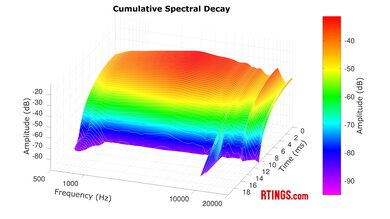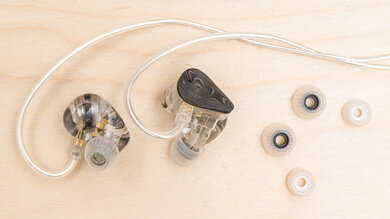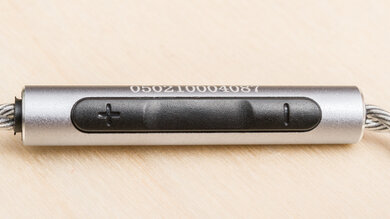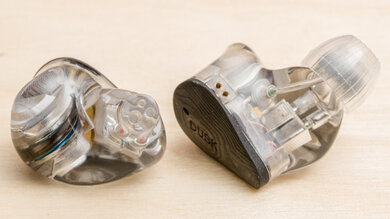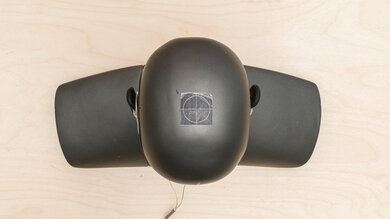The MOONDROP x Crinacle DUSK are premium in-ear monitors (IEMs). A collaboration between MOONDROP and the IEM reviewer Crinacle, these earbuds stand out from other IEMs because they include a USB-C cable with digital signal processing (DSP) capacities. The cable allows users to alter the sound of the buds using EQ presets. But fear not: you can still use these IEMs with their included analog cable. But does the added DSP bring a little extra (sun)light to the DUSK? Read on to find out.
Our Verdict
The MOONDROP x Crinacle DUSK are okay for sports and fitness. These are wired IEMs, so they're not really designed for working out. The cables could easily catch on things, and you won't have as much freedom of movement as you would with wireless buds. They're also not IP-rated against water damage. That said, they're comfortable and have a secure fit, so if you want to go on a long walk or perhaps a very gentle jog, these could do the job in a pinch. But for anything more serious, you'll want to look elsewhere.
-
Comfortable fit.
-
No IP rating.
The MOONDROP Crinacle DUSK are reasonable for commuting and travel. They don't block out much noise and do a poor job of isolating you from the rumble of train and plane engines, but they're comfortable and deliver pretty good sound. That said, they require a cable to work as they don't support Bluetooth, so they might catch on bags and coats if you're in a rush. Their control set is also rather minimal: you won't be able to answer phone calls without looking at your phone. Still, they leak very little audio and are sturdy enough to withstand being dropped, so they're a reasonable choice to accompany you on your travels.
-
Comfortable fit.
-
Adequate mic recording quality.
-
No IP rating.
-
Only alright noise isolation.
The MOONDROP Crinacle DUSK are adequate for office use. On the plus side, they're comfortable enough to wear all day and leak almost no audio. You can blast your favorite tunes without disturbing your coworkers. However, they're not great at blocking out noise around you, so you might be disturbed by chatty colleagues. Their mic also doesn't do a good job of separating your voice from any noise around you, so these aren't a good choice if you make lots of calls from a busy office. But if you work from a private room, they'll do, even if they won't excel.
-
Comfortable fit.
-
Adequate mic recording quality.
-
Mediocre mic noise handling.
-
Only alright noise isolation.
These are wired-only headphones; you can't use them wirelessly.
The MOONDROP Crinacle DUSK are a decent choice for wired gaming. If you connect them via their USB-C cable, you'll get full audio and mic capability at low latency. They also deliver plenty of rumble and boom, so in-game effects feel immersive. That said, their mic is only okay and does a mediocre job separating your voice from any noise around you, so you may prefer to game via the TRS analog connection and bring your own microphone to use alongside these buds. Either way, these are comfortable enough to wear for long gaming sessions.
-
Comfortable fit.
-
Adequate mic recording quality.
-
Mediocre mic noise handling.
-
Only alright noise isolation.
The MOONDROP x Crinacle DUSK have decent audio reproduction accuracy. They don't deviate much from their warm sound profile. While there are some minor differences in amplitude and phase between the left and right drivers, we don't expect you to notice these during regular listening. Since these headphones are in-ears, they don't produce audio that interacts with your outer ear.
The MOONDROP x Crinacle DUSK have alright noise isolation. They don't have ANC, so they can only block out sound passively. They do a decent job blocking out mid-range sound like office chatter, but they block out almost no bass-range noise, so you'll hear the engine rumbles from any passing buses.
The MOONDROP Crinacle DUSK have a mediocre microphone. You sound clear enough, but your voice lacks body and sizzle. The mic also does an unremarkable job separating your voice from ambient noise around you, so these aren't a good choice for taking calls in noisy areas.
The MOONDROP x Crinacle DUSK have decent frequency response consistency. You might experience some slight deviations in sound in the treble region, but if you take time to get a good seal with each wear, it's unlikely you'll notice these.
- 6.8 Sports And Fitness
- 6.9 Travel
- 6.9 Office Work
- 5.1 Wireless Gaming (In Development)
- 7.1 Wired Gaming (In Development)
Performance Usages
- 7.4 Audio Reproduction Accuracy
- 6.8 Noise Isolation
- 6.3 Microphone (In Development)
- 7.3 Frequency Response Consistency
Changelog
-
Updated May 20, 2025:
This review has been updated to Test Bench 2.0, which adds the following tests: Stereo Mismatch, Group Delay, Cumulative Spectral Decay, PRTF, Harmonic Distortion, and Electrical Aspects. We've added new performance usages and updated the text throughout the Sound tests and side-by-sides.
- Updated May 14, 2025: We've converted this review to Test Bench 2.0, which updates our sound tests and adds performance usages. You can read more about this in our changelog.
- Updated Oct 18, 2024: Review published.
- Updated Oct 09, 2024: Early access published.
- Updated Sep 17, 2024: Our testers have started testing this product.
Differences Between Sizes And Variants
The MOONDROP x Crinacle DUSK come in one variant: the bodies of each bud are made out of transparent and white resin, and each bud has a black carbon fiber faceplate. Here is our model's label.
If you encounter another variant of these headphones, please let us know in the comments, and we'll update our review.
Compared To Other Headphones
The MOONDROP x Crinacle DUSK are premium IEMs that stand out from their competitors through their inclusion of a DSP cable that allows you to EQ their sound. Out of the box, the DUSK have a little more thump and rumble than the MOONDROP Blessing 3 but lack the Blessing 3's detail and sizzle. The TRUTHEAR x Crinacle ZERO: RED don't have as controlled a sound profile as the DUSK, while the TRUTHEAR x Crinacle ZERO can't match the DUSK for low-end rumble, but they have a bit more sizzle out of the box. That said, both of Crinacle's collaborations with TRUTHEAR are much cheaper than the DUSK, but don't come with DSP cables to customize their sound to your tastes.
If you want more high-quality sound headphones, check out our recommendations for the best audiophile headphones. You can also check out the best in-ear headphones and the best headphones for music.
The MOONDROP x Crinacle DUSK and the MOONDROP Blessing 3 are premium IEMs. Both pairs have generally well-balanced bass mid-ranges. The DUSK have a little extra thump, which hip-hop fans might enjoy, while the Blessing 3 have a flatter, more controlled bass. Their main sonic differences lie at the other end of the frequency spectrum. The Blessing 3, though warm, have more sizzle and detail than the DUSK, which can sound a little dull by comparison. But you might prefer that softer sound. The main difference between these IEMs is that the DUSK come with both an analog cable and a USB-C cable with DSP that you can use to apply EQ curves to your audio.
The MOONDROP x Crinacle DUSK and the TRUTHEAR x Crinacle ZERO: RED target different kinds of users. The MOONDROP are priced for premium listeners who are willing to pay extra for perks like their DSP cable that allows you to apply presets to their sound. On the other hand, the TRUTHEAR perform very well for their price and have a more detailed treble range than the MOONDROP. Fans of sizzle and bite might find the MOONDROP's subdued presentation a little boring. However, both pairs will suit listeners who prefer a smoother top end.
The MOONDROP x Crinacle DUSK and the TRUTHEAR x Crinacle ZERO target different segments of the IEM market. Fans of EDM will appreciate the full but well-balanced sound of the MOONDROP's low-end, while their mid-range presents vocals and instruments with detail and accuracy. The much more affordable TRUTHEAR can't match the MOONDROP for bass and mid-range compliance, but their treble range is more detailed, presenting drum cymbals with more sizzle and presence. The MOONDROP sound a little dull by contrast. But one person's dull is another person's smooth, and you can customize the MOONDROP via EQ presets applied via their DSP cable.
The MOONDROP x Crinacle DUSK and the THIEAUDIO Monarch MKIII are premium IEMs targeted at users looking for the very best sound reproduction. Both pairs have fairly similar sound profiles, offering plenty of thump and rumble in the low end, though the THIEAUDIO offer a more present low-treble range, which can help make vocals sound a little clearer in dense mixes. But both pairs present instruments and vocals accurately. But the THIEAUDIO are significantly more expensive than the MOONDROP and lack the MOONDROP's DSP cable, which allows you to apply EQ presets to your audio.
Video
Test Results
The MOONDROP DUSK have a warm sound profile. They've added low- and mid-bass for extra thump and rumble, which is great for fans of dance music and hip-hop. The mid-range generally reproduces audio accurately, but the treble is a little recessed, which you might find smooth or dull, depending on your tastes. It's worth noting that the bass and mid-range hew closely to the Harman IEM target. If you use the USB-C cable to listen to audio and have an Android device, you also gain access to an EQ with several presets that change the sound slightly.
Since these headphones can be connected to your devices via an analog cable or a digital USB-C cable, it's important to note that we used the analog connection for our frequency response tests and the USB-C cable for all other tests. Features such as the microphone are only available via USB-C. That said, the cables have similar frequency responses.
These buds have decent frequency response consistency. The most noticeable deviations are in the mid- and high-treble regions, where our hearing is less sensitive, anyway. In general, if you take the time to get a good fit, you'll get consistent audio with each wear.
The MOONDROP DUSK have fantastic compliance with our bass target. There's plenty of low-bass on tap, so kick drums in songs like Last Bloom by Floating Points have plenty of thump. The bass response is well-controlled throughout, without any sharp peaks or dips, and the mid-bass and high-bass are virtually flat, so you won't hear random notes jumping out at you unnaturally.
The mid-range target compliance is outstanding. There's a wide dip between the low- and mid-mids that can ever so slightly thin out instruments like guitars, but the rest of those regions are virtually flat, so it's hard to notice. The high-mids are slightly boosted, which brings vocals to the front of busy pop mixes. In songs like Send My Love (To Your New Lover) by Adele, the vocals sound suitably prominent and powerful for a belting pop singer without ever becoming annoyingly harsh.
The treble target compliance is great. The entire range is de-emphasized a little, which gives these IEMs a slightly warm tonality. There aren't any narrow dips or peaks in the low-treble, but the entire range is recessed, so instruments like electric guitars lose a little detail. The mid-treble is also reduced, which makes percussion sounds like cymbals a touch dull. On the plus side, sibilants like S and T sounds are never piercing, with a warm tonality that some people may enjoy.
The peaks and dips performance is excellent. The bass- and mid-ranges follow their own sound profile especially well. There's a little more deviation from the mid-treble range and up, but that's to be expected since that part of the frequency range is hugely affected by the shape of your particular ear anatomy. You might find some sounds like cymbals a little uneven, veering between slightly piercing or slightly dull, but it won't be a big problem.
The headphones' L/R drivers are decently well-matched. There are some small differences in amplitude between the left and right drivers in the bass and lower-mids, but these aren't very audible with real-world content. There are some bigger amplitude differences in the mid- and high-treble regions, which can cause centrally panned hi-hats to sound slightly one-sided, but many people can't hear such high frequencies, anyway. The drivers are generally well-matched in phase. You might notice some bass notes in the high-bass sound slightly off to one side, but it's unlikely with day-to-day listening.
The group delay performance is good and falls below the audibility threshold. The headphones reproduce tight bass, well-defined transients, and transparent treble.
These IEMs sit inside your ears and therefore don't produce audio that interacts with your outer ear.
These IEMs have satisfactorily low harmonic distortion. Even when listening at high volumes, you can expect decently clear audio reproduction.
These headphones don't require an amp to drive them during wired use.
These are the settings used to test these headphones. Our results are only valid when used in this configuration. We used the analog connection for our frequency response tests and the USB-C cable for all other tests.
The MOONDROP Crinacle DUSK are stylish IEMs. Their bodies are made of transparent and white marbled resin, and each bud is covered with a black carbon fiber fascia. Each bud contains three drivers: a dynamic driver, a balanced armature driver, and a planar magnetic driver. They come with two audio cables: a standard analog cable with a 3.5mm jack and a USB-C cable that includes DSP power so you can apply EQs to your audio. They ship with five EQ presets to start with, but you can create your own presets using the Android app (sorry, iOS users) and then flash those presets to the cable. Like other MOONDROP headphones, the box and manuals include waifu-style cartoons.
The MOONDROP DUSK have a comfortable fit for most people. They come with three different sizes of silicone tips so you'll likely be able to find a set that fits your anatomy. The tips form a good seal with your ear without applying too much pressure to the inside of your ear canal. Any pressure they apply is evenly spread across the whole surface area of the tip. On the other hand, the cable, which curls behind your ears as is common with IEMs, can rub against your skin and become uncomfortable over time. They're a little heavier than most IEMs we've tested but not as heavy as the THIEAUDIO Monarch MKIII, so you shouldn't feel fatigued when wearing them.
The USB-C cable that comes with the buds offers passable controls. There are only three buttons on the control surface: a center button, which plays or pauses your audio, and plus and minus buttons, which control the volume of your audio. The buttons are easy to use, but if you're not paying attention to the orientation of the cable, you might get the plus and minus buttons confused with one another. Pushing the buttons provides obvious tactile feedback so you know when you've entered a command.
The MOONDROP DUSK come with a great case that's similar to other cases from the brand, such as the one that comes with the MOONDROP Blessing 3. It's a hard shell case with a leatherette exterior and soft cloth interior. All of the materials used feel premium. It closes with a zipper, and on the inside you'll find a small pouch to store any small accessories in.
The MOONDROP DUSK have a great build quality. The silicone tips feel robust and flexible, so they'll adjust to your ear canal without becoming strained. The bodies of each bud are made from high-quality medical resin with a carbon fiber fascia, giving them a premium feel. Like many other IEMs, the pins that connect the cable to the body of each bud are small and could be damaged easily. It's worth being cautious when plugging or unplugging the tiny connectors. These buds also don't have an IP rating, so these aren't a good choice for taking out with you on a rainy day.
Like the MOONDROP Blessing 3, the MOONDROP DUSK have a stable fit. Once you've found the right silicone tip size for your anatomy, they sit snugly in your ear. Just make sure the tips aren't too big, or they can become dislodged. The cable that wraps around your ears helps keep them in place when you move around. They'll stay in your ears even when headbanging to your favorite Rage Against the Machine tunes.
These headphones have okay noise isolation. They don't have ANC, so you're reliant on the passive isolation formed by the seal between the silicone tips and your ears. That seal blocks out almost no bass-range sounds: you'll definitely hear the engine of a passing bus along with your audio. The buds fare much better with mid-range sounds like office chatter, so they're a fair choice for wearing at the office. And they do a very good job blocking out high-pitched sounds like fan whine. It's worth noting that the peak in the low-bass is an artifact of our testing process: you won't hear rumble added to your audio.
These IEMs do a passable job of blocking out everyday sounds. They won't isolate you from the rumble of an airplane engine or buses on the street, but they'll greatly reduce the sounds of your chatty coworkers and that AC over in the corner. The peak in the low-bass is an artifact of our testing process.
The leakage performance is superb. Any audio that does escape is concentrated in the bass and treble regions, so it won't sound very detailed or comprehensible to anyone nearby. But you'd have to be blasting your tunes dangerously loud for people to hear what you were listening to in the first place.
If you use the USB-C cable to connect these buds to your device, you gain access to a reasonably good microphone. The recording quality is adequate. Your voice doesn't sound full-bodied, but it's captured with enough presence and detail to be clear to whoever you're talking to.
The mic has passable noise handling. It doesn't do a good job of separating your voice from any noise around you. In a chatty office, your voice will still be clear to the person you're talking to, but if you're making a call in a very loud place like a subway station, you'll be drowned out by the roar of a passing train.
Unlike most IEMs, such as the MOONDROP Blessing 3, the MOONDROP DUSK come with a sub-par app that only works on Android devices. The app allows you to change the EQ settings stored in the USB-C cable, and to run firmware updates. There are five EQ presets to choose from, and you can also build your own, but you can't customize one of the existing presets. That said, the EQ is fully parametric, allowing you to change the gain, frequency, and bandwidth of each node. You can also browse for publicly shared EQ presets using the app.
The MOONDROP DUSK come with two cables: a 47-in/1.2-m detachable TRS cable and a 47-in/1.2-m detachable USB-C cable. The TRS cable plugs into standard 1/8 in / 3.5mm ports. The USB-C cable works with phones and computers that have USB-C ports and includes some DSP to change the sound of these IEMs. The DSP works regardless of your phone's OS, but you can only customize the sound using Android. Android users also have a few presets to pick from.
If you connect these to your PC with the analog TRS cable, you can receive audio, but you'll need an external mic if you plan to chat while gaming. On the other hand, if you connect them to your PC via their USB-C cable, you can use the built-in mic for full audio and microphone capability.
The USB-C cable doesn't work with PlayStation, so you'll have to use the analog TRS cable if you plan to game with these buds. If you plug these into your PlayStation's AUX port you'll be able to receive audio, but they don't have a mic, so you'll need to add one if you want to chat while you game.
The USB-C cable is not compatible with Xbox. You can plug the TRS cable into your Xbox controller's AUX port, but they can only receive audio as they don't have a microphone.


